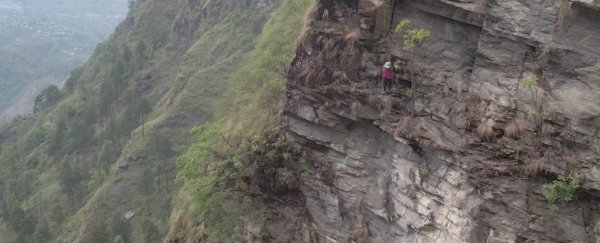The journey to harvest hallucinogenic honey produced by Himalayan giant honey bees is far from easy. In eastern Nepal, select members of the Kulung people scale bamboo rope ladders up 300-foot (91 metre) cliffs to get it.
They ward off swarms of the bees with smoke from burning grass, which is attached to a pole, while trying to gather the precious liquid.
The stories of the people who make that journey are documented in "The Last Honey Hunter," a film that's currently appearing at festivals and will be released in 2018.
It looks stunning, as you can see in this behind-the-scenes video, posted by The North Face on YouTube.
The filmmaking team included accomplished climbers like filmmaker and photographer Renan Ozturk. They got far enough up the cliffs themselves to shoot the hunt, though the crew was tied into safety harnesses. The honey hunters simply made their way up tall, skinny ladders.
"Anytime when you felt a little overwhelmed you just looked at [honey hunter and Kulung elder] Mauli without the bee suit on the bamboo ladder with no harness," one member of the team said in the video.
Depending on the season, these bees make different types of honey, according to Mark Synnott, who was part of the filmmaking team and wrote about the honey hunters for National Geographic. In the spring, toxins in the flowers they eat create psychotropic "mad" or red honey.
"I ate two teaspoons, the amount recommended by the honey hunters, and after about 15 minutes, I started to feel a high similar to weed.
"I felt like my body was cooling down, starting from the back of my head and down through my torso. A deep, icy hot feeling settled in my stomach and lasted for several hours," wrote David Caprara for Vice in 2016 after travelling to Nepal to witness a different honey hunt.
He says a larger dose can be even more intense.
The village's honey trader described the experience of ingesting a larger amount of red honey to Synott. First, the body feels a need to purge (vomit or defecate).
"After the purge you alternate between light and dark. You can see, and then you can't see," Synott was told. "You can't move, but you're still completely lucid." That high can last for a day, with a sound like a beehive pulsing away.
Nepali locals use small doses of the honey as an antiseptic, a cough medicine, or for pain relief. It is sold on the black market for US$60 to US$80 a pound (US$130-175 per kg), according to Synnott. That's what has made the death-defying hunt worth it for so long.
But the traditional honey hunts, which are conducted in an environmentally sustainable way, may not be around for much longer. The village documented in this film has no one to replace lead hunter Mauli, since young people are less interested and more likely to move away to cities.
In 2013, photographer Andrew Newey travelled to Nepal to document the hunts, and said honey bee populations there are declining due to tourism and government policies that award hunting privileges to contractors that don't harvest sustainably.
Some form of the hunt may continue, but the traditional sustainable harvest — and perhaps the hallucinogenic honey itself — may not last long.
This article was originally published by Business Insider.
